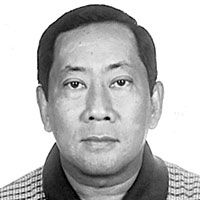Passing through the Hong Kong-Macao bridge

Hong Kong/Macao — One of the reasons why we left Cebu for Hong Kong is to celebrate my wife’s birthday last Sunday and to spend our New Year’s celebration for the first time out of Cebu City. The reason why we’ve always stayed in Cebu in all my years until today is due to the fact that in the olden days of Cebu City back in the 1960’s, since we moved to our present residence in Capitol Hill, we’ve always had a terrific view of our New Year’s celebration hosted by the Avila Family and even went on after my father passed away in 1979.
But in the last five years the fireworks have dramatically diminished. Way back in the 1960’s fireworks would start at 11:30 pm and end after New Year’s Day at 12:30 am. Last year, what little fireworks we had started blowing up 10 minutes before 12 am and ended by 12:20 am. Call it pathetic but this is how New Year’s Eve is now celebrated in Cebu and this is due to the warnings of the Department of Health (DOH) and the Philippine National Police (PNP) who wants to stop people from exploding pyrotechnics so their hands won’t be maimed. This has always been the headline news that greeted us a day after the New Year’s Revelry.
Of course since all my children and grandchildren want to stay in Disneyland Hong Kong, I guess the time was ripe to greet the Year 2020 differently and what a great day it has been for our family as we experienced for the very first time a trip to Macao, not by ferry service, but using a bus travelling the Hong Kong-Zhuhai-Macau Bridge, which is a 55-kilometer bridge-tunnel system consisting of a series of three cable-stayed bridges, an undersea tunnel, and four artificial islands. It is both the longest sea crossing and the longest open-sea fixed link on earth that opened last October 2018.
This greatest road infrastructure opened last year. Construction began in 2009, the construction cost was at 127 billion yuan ($18.8 billion). Passing through the HZM Bridge was a wonderful experience and from Hong Kong it only took us 40 minutes, while the return trip was only 35-minutes long. What was totally unexpected or perhaps, this merely skipped my mind was that Hong Kong was a Special Administrative Region (SAR) totally different from the government of Macao.
In short, if you come from Hong Kong, you have to go to the Hong Kong Port Bus Terminal, which surprisingly was a huge facility that would cater to tourists leaving the Port Hong Kong for Macao or Zuhai. This means you need to line up for immigration and show them your passport. Only then can you purchase a bus ticket around 80 Hong Kong dollars. What was remarkable in this HK Port Terminal was, it was huge, some would even say that it was overbuilt.
Getting into Macao, you can notice the huge changes like we ended up not in the Ferry Terminal like the three previous times I went to Macao. But apparently the Macao government also built a Macao Port Bus Terminal equally as huge as the one in Hong Kong. The only positive thing for us is that, thanks to the huge immigration facilities of both counrties, we didn’t have to suffer through the long lines or queues that plagues international airports of the world. I really don’t know it this has something to do with the protest troubles that have plague Hong Kong for months.
One added bonus for me is that, I love Portuguese food, ever since then we visited Ambassador Frank Benedicto in Rio de Janiero. It was then I tried Brazil’s native dish called Feijoada, which are black beans with pork entrails made into stew and sausages or chorizo. The entrails are given to the poor people while the rich eat the best parts of the pork. Of course we also had Bacalhau and other Portuguese and Macanese culinary delights. But it was the first time I tasted Feijoada in 20 years.
Since it was the first time for my children and grandchildren to visit Macau, we also dropped by The Venetian Resort, which for me is even bigger than the Venetian Resort in Las Vegas. But we only had a very little time as for this trip, it was merely to satisfy my bucket list to try the longest bridge in the world. My grandkids can always comeback to Macao with their parents now that they have tasted the Macanese cuisine.
On our return to Hong Kong, we had to start by going to the Macao Port to bring our passports to the immigration and after a 35 minute ride, we entered Hong Kong again passing through the immigration. This is what using the Hong Kong-Zhuhai-Macao Bridge means to those who wish to visit Macao in the Year 2020.
At this point, I’d like to exhort the officers of NEDA and let them try the Hong Kong-Zhuhai-Macao Bridge so that perhaps they would reconsider thinking hard that the Cebu-Bohol Bridge might not cost as much as the US$18.8 billion as there is no need to build two immigration buidlings.
* * *
Email: [email protected].
- Latest
- Trending





























